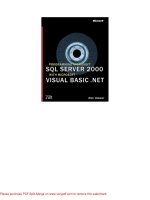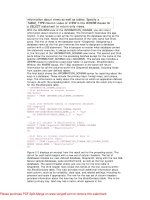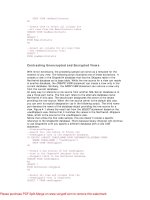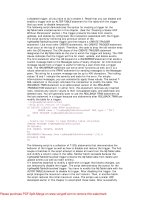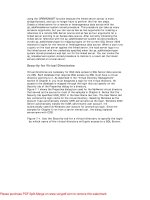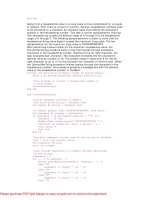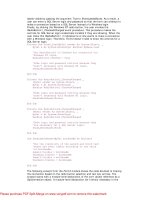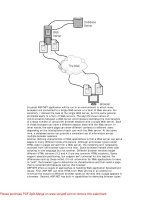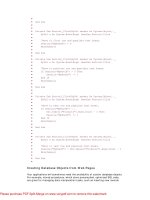Microsoft SQL Server 2000 Programming by Example phần 5 pps
Bạn đang xem bản rút gọn của tài liệu. Xem và tải ngay bản đầy đủ của tài liệu tại đây (620.43 KB, 71 trang )
Chapter 7. Enforcing Data Integrity
269
1 1 2000-11-12 23:55:00
2 1 2000-11-12 23:55:00
6 3 2000-11-12 23:55:00
7 3 2000-11-12 23:55:00
Cascading Updates
To define a FOREIGN KEY constraint as a cascaded UPDATE action, you must use the ON UPDATE CASCADE
in the REFERENCES clause of the FOREIGN KEY definition on the CREATE TABLE or ALTER TABLE
statements.
Listing 7.18 is based in the same example as in Listing 7.17. You create the Customers table and the
Orders table. You define a FOREIGN KEY constraint between these two tables with the ON UPDATE
CASCADE option. You want to change the ID of customer 3 to 30. Customer 3 has two related rows in the
Orders table. The UPDATE operation changes the CustomerID from 3 to 30 in both tables automatically.
Caution
It is not recommended to change PRIMARY KEY values. This can produce identity integrity
problems in your applications.
Listing 7.18 Cascade Changes on Primary Keys to Related Foreign Keys with FOREIGN KEY
Constraints Defined As ON UPDATE CASCADE
Create Customers and Orders tables
CREATE TABLE Customers(
CustomerID int
PRIMARY KEY,
CustomerName varchar(20) NOT NULL)
CREATE TABLE Orders(
OrderID int
IDENTITY(1,1)
PRIMARY KEY,
CustomerID int NOT NULL,
OrderDate smalldatetime NOT NULL
DEFAULT CURRENT_TIMESTAMP)
GO
Create the FOREIGN KEY constraint
with CASCADE
ALTER TABLE Orders
ADD CONSTRAINT FK_Orders
FOREIGN KEY (CustomerID)
REFERENCES Customers (CustomerID)
ON DELETE CASCADE This is optional
ON UPDATE CASCADE
Microsoft SQL Server 2000 Programming by Example
270
GO
Insert some Customers
INSERT Customers
VALUES (1, 'MyComp corp.')
INSERT Customers
VALUES (2, 'ACME Inc.')
INSERT Customers
VALUES (3, 'NewDotCompany Ltd.')
Insert some Orders
with the default Date
INSERT Orders (CustomerID)
VALUES (1)
INSERT Orders (CustomerID)
VALUES (1)
INSERT Orders (CustomerID)
VALUES (2)
INSERT Orders (CustomerID)
VALUES (2)
INSERT Orders (CustomerID)
VALUES (2)
INSERT Orders (CustomerID)
VALUES (3)
INSERT Orders (CustomerID)
VALUES (3)
Show the data
PRINT CHAR(10) + 'Original Customers table'+ CHAR(10)
SELECT *
FROM Customers
PRINT CHAR(10) + 'Original Orders table'+ CHAR(10)
SELECT *
FROM Orders
GO
Update Customer 3
Change CustomerID from 3 for 30
UPDATE Customers
SET CustomerID = 30
WHERE CustomerID = 3
PRINT CHAR(10) + 'Customers table after update Customer 3'+ CHAR(10)
SELECT *
FROM Customers
Chapter 7. Enforcing Data Integrity
271
PRINT CHAR(10) + 'Orders table after update Customer 3'+ CHAR(10)
SELECT *
FROM Orders
GO
DROP TABLE Orders
DROP TABLE Customers
Original Customers table
CustomerID CustomerName
1 MyComp corp.
2 ACME Inc.
3 NewDotCompany Ltd.
Original Orders table
OrderID CustomerID OrderDate
1 1 2000-11-12 23:59:00
2 1 2000-11-12 23:59:00
3 2 2000-11-12 23:59:00
4 2 2000-11-12 23:59:00
5 2 2000-11-12 23:59:00
6 3 2000-11-12 23:59:00
7 3 2000-11-12 23:59:00
Customers table after update Customer 3
CustomerID CustomerName
1 MyComp corp.
2 ACME Inc.
30 NewDotCompany Ltd.
Orders table after update Customer 3
OrderID CustomerID OrderDate
1 1 2000-11-12 23:59:00
2 1 2000-11-12 23:59:00
3 2 2000-11-12 23:59:00
4 2 2000-11-12 23:59:00
5 2 2000-11-12 23:59:00
6 30 2000-11-12 23:59:00
7 30 2000-11-12 23:59:00
Microsoft SQL Server 2000 Programming by Example
272
Transact-SQL–Specific Integrity Structures
Transact-SQL language provides an alternative to the CHECK and DEFAULT constraints with the RULE and
DEFAULT objects. RULE and DEFAULT objects are not ANSI standard, so it is advisable to use constraints as
a general way to provide the same functionality.
One of the reasons to use these Transact-SQL objects is to create self- contained user-defined data types,
including not only the data type, but also the DEFAULT value and the RULE to check for domain integrity. If a
column uses one of these self-contained user-defined data types as a data type, this column will inherit the
DEFAULT definition and the RULE definition as well.
User-defined data types were covered in Chapter 2.
Using DEFAULT and RULE objects can help during the development process, if the same condition must be
applied to multiple columns. However, remember that they are not ANSI compliant.
DEFAULT Objects
DEFAULT objects are similar to the DEFAULT definition of a column, but you can create a DEFAULT object
independently of any column and bind it to specific columns or user-defined data types later.
To create a DEFAULT object, you use the CREATE DEFAULT statement, providing a unique name for the
DEFAULT object and defining the object as a constant, built-in function or any valid scalar expression.
To delete a DEFAULT object, you must use the DROP DEFAULT statement. You cannot drop a DEFAULT
object if it is used anywhere in your database.
Caution
The only way to modify a DEFAULT or RULE object definition is by dropping and re- creating the
object. Before dropping the object, you must unbind the object from any field and user-defined data
type.
To bind a DEFAULT object to a field or user-defined data type, you must use the sp_bindefault system
stored procedure, and the sp_unbindefault disconnects a bound DEFAULT object from a field or user-
defined data type. Only one DEFAULT definition or DEFAULT object can be defined per column; binding a new
DEFAULT object to a column overrides the existing one.
Note
DEFAULT and RULE objects are local to a database. Therefore, DEFAULT and RULE objects
created in the Master database can be used only in the Master database.
You can see a complete example of how to use DEFAULT objects in Listing 7.19.
Listing 7.19 Create Independent DEFAULT Objects and Bind Them Later to Any Field or User-Defined
Data Type
Chapter 7. Enforcing Data Integrity
273
Create a DEFAULT object using a constant
CREATE DEFAULT NoSales
AS 0
GO
Create DEFAULT objects using expressions
based on built-in functions
CREATE DEFAULT ThisMonth
AS Month(CURRENT_TIMESTAMP)
GO
CREATE DEFAULT UserDB
AS SYSTEM_USER
+ '- '+ DB_NAME(DB_ID())
GO
Create two User-Defined Data Types
EXEC sp_addtype 'UDDTLoginDB', 'nvarchar(256)', 'NULL'
EXEC sp_addtype 'UDDTSales', 'money', 'NULL'
GO
Create a table to test the DEFAULT objects
and the User-Defined Data Types
CREATE TABLE TestDefaults(
ID int NOT NULL
IDENTITY(1,1)
PRIMARY KEY,
TotalSales money NULL,
SalesMonth tinyint NULL,
WhoWhere UDDTLoginDB)
GO
Insert a new empty row in the table
INSERT TestDefaults
DEFAULT VALUES
PRINT char(10) + 'No defaults defined'+ CHAR(10)
SELECT *
FROM TestDefaults
GO
Bind the NoSales DEFAULT object
to the TotalSales field in the TestDefaults table
EXEC sp_bindefault 'NoSales', 'TestDefaults.TotalSales'
GO
Microsoft SQL Server 2000 Programming by Example
274
Insert a new empty row in the table
INSERT TestDefaults
DEFAULT VALUES
PRINT CHAR(10) + 'Only DEFAULT on TotalSales defined'+ CHAR(10)
SELECT *
FROM TestDefaults
GO
Bind the ThisMonth DEFAULT object
to the SalesMonth field in the TestDefaults table
EXEC sp_bindefault 'ThisMonth', 'TestDefaults.SalesMonth'
GO
Insert a new empty row in the table
INSERT TestDefaults
DEFAULT VALUES
PRINT CHAR(10) + 'DEFAULT defined on TotalSales and SalesMonth'+ CHAR(10)
SELECT *
FROM TestDefaults
GO
Bind the UserDB DEFAULT object
to the UDDTLginDB User-Defined Data Type
EXEC sp_bindefault 'UserDB', 'UDDTLoginDB'
GO
Insert a new empty row in the table
INSERT TestDefaults
DEFAULT VALUES
PRINT CHAR(10) + 'DEFAULT defined on TotalSales, SalesMonth'
PRINT 'and the UDDTLoginDB User-Defined Data Type'+ CHAR(10)
SELECT *
FROM TestDefaults
GO
Add a new column to the TestDefaults table
Using the UDDTSales data type
ALTER TABLE TestDefaults
ADD ProjectedSales UDDTSales
GO
PRINT CHAR(10) + 'Add an empty field using the UDDTSales data type'+ CHAR(10)
SELECT *
FROM TestDefaults
GO
Bind the NoSales DEFAULT object
to the UDDTSales User-Defined Data Type
Chapter 7. Enforcing Data Integrity
275
for future columns only
EXEC sp_bindefault 'NoSales', 'UDDTSales', 'futureonly'
GO
Insert a new empty row in the table
INSERT TestDefaults
DEFAULT VALUES
PRINT CHAR(10) + 'DEFAULT defined on UDDTSales data type as futureonly'
PRINT 'does not affect the existing fields using this UDDT'+ CHAR(10)
SELECT *
FROM TestDefaults
GO
Drop everything in order
Table first
UDDT next
DEFAULT last
DROP TABLE TestDefaults
EXEC sp_droptype 'UDDTSales'
EXEC sp_droptype 'UDDTLoginDB'
DROP DEFAULT NoSales
DROP DEFAULT ThisMonth
DROP DEFAULT UserDB
Type added.
Type added.
No defaults defined
ID TotalSales SalesMonth WhoWhere
1 NULL NULL NULL
Default bound to column.
Only DEFAULT on TotalSales defined
ID TotalSales SalesMonth WhoWhere
1 NULL NULL NULL
2 .0000 NULL NULL
Microsoft SQL Server 2000 Programming by Example
276
Default bound to column.
DEFAULT defined on TotalSales and SalesMonth
ID TotalSales SalesMonth WhoWhere
1 NULL NULL NULL
2 .0000 NULL NULL
3 .0000 11 NULL
Default bound to data type.
The new default has been bound to columns(s) of the specified user data type.
DEFAULT defined on TotalSales, SalesMonth and the UDDTLoginDB User-Defined Data
Type
ID TotalSales SalesMonth WhoWhere
1 NULL NULL NULL
2 .0000 NULL NULL
3 .0000 11 NULL
4 .0000 11 sa - ByExample
Add an empty field using the UDDTSales data type
ID TotalSales SalesMonth WhoWhere ProjectedSales
1 NULL NULL NULL NULL
2 .0000 NULL NULL NULL
3 .0000 11 NULL NULL
4 .0000 11 sa - ByExample NULL
Default bound to data type.
DEFAULT defined on UDDTSales data type as future only does not affect the
existing fields
using this UDDT
ID TotalSales SalesMonth WhoWhere ProjectedSales
1 NULL NULL NULL NULL
2 .0000 NULL NULL NULL
3 .0000 11 NULL NULL
4 .0000 11 sa - ByExample NULL
5 .0000 11 sa - ByExample NULL
Type has been dropped.
Type has been dropped.
Rule Objects
RULE objects are similar to CHECK constraints. However, you can create a RULE object independently of any
column and bind it later to specific columns or user-defined data types.
To create a RULE object, you use the CREATE RULE statement, providing a unique name for the RULE object
and defining the object as any expression that returns TRUE or FALSE.
Caution
You can't use user-defined functions as part of a DEFAULT or RULE object definition.
Chapter 7. Enforcing Data Integrity
277
To delete a RULE object, you must use the DROP RULE statement. You cannot drop a RULE object if it is used
anywhere in your database.
To bind a RULE object to a field or user-defined data type, you must use the sp_bindrule system stored
procedure, and the sp_unbindrule disconnects a bound RULE object from a field or user-defined data type.
You can bind only one rule to a user-defined data type or a table field. However, a rule can coexist with one or
more CHECK constraints in a field; in this case, all the conditions will be checked. If you bind a new rule to a
field or user-defined data type, the old rule will be unbound automatically.
You can see an example of how to use RULE objects in Listing 7.20.
Listing 7.20 Create Independent RULE Objects and Bind Them Later to Any Field or User-Defined Data
Type
Define a Table to test RULE Creation
CREATE TABLE NewEmployees (
EmployeeID int NOT NULL,
EmployeeName varchar(50) NOT NULL,
PostCode char(5) NOT NULL )
GO
Create the RULE object
CREATE RULE RUPostCode
AS
(@PCode LIKE '[0-9][0-9][0-9][0-9][0-9]')
GO
Bind the RULE to the PostCode column
EXEC sp_bindrule 'RUPostCode', 'NewEmployees.PostCode'
GO
Insert data in the table to test the RULE
INSERT NewEmployees
VALUES (1, 'Paul', 'GL513')
INSERT NewEmployees
VALUES (2, 'Eladio', '01380')
SELECT *
Microsoft SQL Server 2000 Programming by Example
278
FROM NewEmployees
GO
DROP TABLE NewEmployees
GO
DROP RULE RUPostCode
GO
Rule bound to table column.
Server: Msg 513, Level 16, State 1, Line 1
A column insert or update conflicts with a rule imposed by a previous CREATE RULE
statement. The statement was terminated. The conflict occurred in database
'ByExample',
table 'NewEmployees', column 'PostCode'.
The statement has been terminated.
EmployeeID EmployeeName PostCode
2 Eladio 01380
Note
The definition of the RULE object contains a variable. The name of this variable is not relevant; it
just represents the column to where the RULE object will be bound.
Note
Remember to keep it simple. Overengineering a database will produce execution overhead and a
difficult maintenance.
What's Next?
This chapter covered the creation and use of structures to enforce data integrity.
Chapter 8 covers the creation of stored procedures, where you can test the integrity of the data before
attempting any modification, having extra data control and access to more complex condition checking.
Chapter 9 covers triggers, which is another way to enforce data integrity. In that chapter, you will see how to
create triggers to enforce domain integrity and referential integrity.
User-defined functions are covered in Chapter 10. It is possible to use UDF as part of constraint definitions.
This new feature gives you tremendous flexibility in the definition of DEFAULT and CHECK constraints.
Chapter 8. Implementing Business Logic: Programming Stored Procedures
279
Chapter 8. Implementing Business Logic: Programming
Stored Procedures
A stored procedure is a database object that comprises one or more Transact-SQL statements. The main
difference between a stored procedure and a set of statements is that a stored procedure can be reused just
by calling its name. Therefore, if you want to rerun the code, you don't have to execute the whole set of
statements that compose the stored procedure one by one.
As a database developer, you will spend most of your time coding, fixing, and optimizing stored procedures
because they can be used for thousands of purposes. Not only can they be used to encapsulate business
logic for your applications, they also can be used for administrative purposes inside SQL Server.
This chapter teaches you the following:
• The benefits of using stored procedures
• The types of stored procedures in SQL Server
• The types of stored procedure parameters
• How to create, alter, and execute stored procedures
• How to handle errors in stored procedures
• Security considerations when working with stored procedures
Benefits of Using Stored Procedures
Usually, stored procedures are used to encapsulate or enforce business rules in your databases. For example,
if you have to do some calculations before inserting data in a table, you can embed this logic in a stored
procedure and then insert the data using this stored procedure. Similarly, if you don't want users to directly
access tables and any other objects, you can create stored procedures to access these objects and have
users use them, instead of manipulating objects directly. For example, Microsoft discourages users from
making direct modifications to system tables; however, SQL Server comes with system stored procedures to
manipulate system tables.
Caution
If you develop applications that modify system tables, you should stop doing this. Be advised that
in future releases of SQL Server, Microsoft won't allow users to modify system tables directly.
The following are the benefits and advantages of stored procedures:
• They are precompiled statements— An execution plan (or access plan) is created and stored in
memory the first time the stored procedure is run, and it is subsequently used each time you execute
the stored procedure, thus minimizing the time it takes to run. This is more efficient than executing
each statement separately, one by one, because SQL Server would have to generate an access plan
for each statement every time it is run.
• They optimize network traffic— You might say that stored procedures aren't related to network traffic
at all. However, when you execute a stored procedure that contains many statements, you just have
to call the stored procedure once, not each statement separately. In other words, the entire block of
code (the whole set of statements) doesn't need to be sent from the client to the server. For example,
if you create a stored procedure with 10 statements and execute it, you need to send only one
instruction to SQL Server instead of 10 separate instructions. This translates into fewer round trips to
SQL server, thus optimizing network traffic.
• They can be used as a security mechanism— In particular, if the owner of an object doesn't want to
give direct permissions to users on database objects, he can create stored procedures that
manipulate these objects, and then give execute permissions on these stored procedures to users.
Microsoft SQL Server 2000 Programming by Example
280
This way, users will be allowed only to execute these stored procedures, and they won't be able to
directly manipulate the objects that stored procedures reference. System stored procedures are an
example of this approach. SQL Server provides system stored procedures to prevent users from
dealing directly with system tables.
• They allow modular programming— You can encapsulate your business logic inside stored
procedures, and then just call them from applications. Therefore, all statements that make up a stored
procedure are executed as a whole in the server. Furthermore, you can embed conditional logic in a
stored procedure using any of the control of flow statements (IF ELSE, WHILE) available in
Transact-SQL.
• They can be set to execute automatically when SQL Server starts— Any routine task that must be
executed whenever the SQL Server service starts can be programmed as a stored procedure and
then configured to run automatically using the sp_procoption system stored procedure.
• They can use parameters— This is one of the ways that stored procedures have to receive data from
and return it to the calling application. Parameters can be either input, which are similar to variables
passed by value, or output, which behave as variables passed by reference.
Types of Stored Procedures
In SQL Server, there are four types of stored procedures: system stored procedures, user-defined stored
procedures, temporary stored procedures, and extended stored procedures. System and extended stored
procedures are created automatically at installation time. The other types (user-defined, temporary) are the
ones users create explicitly.
System Stored Procedures
System stored procedures are created automatically in system databases when you install SQL Server. They
are basically a way to interact with system tables. Moreover, there is a system stored procedure for almost
any administrative task you perform in SQL server. Also, because Microsoft doesn't recommend dealing
directly with system tables, this is the preferred way to deal with them.
Every global system stored procedure's name has the sp_ prefix, and for this reason they can be executed
from any database. Listing 8.1 demonstrates this feature, calling the sp_helpdb system stored procedure
(which gives general information about databases) from the Northwind database.
Listing 8.1 Executing a System Stored Procedure (Which Is Stored in Master) from the Northwind
Database
USE Northwind
GO
sp_helpdb
Chapter 8. Implementing Business Logic: Programming Stored Procedures
281
The output has been simplified
name db_size owner dbid created compatibility_level
master 12.19 MB sa 1 Aug 6 2000 80
model 1.13 MB sa 3 Aug 6 2000 80
msdb 13.50 MB sa 4 Aug 6 2000 80
Northwind 3.94 MB sa 6 Aug 6 2000 80
pubs 2.13 MB sa 5 Aug 6 2000 80
tempdb 8.50 MB sa 2 Jan 22 2001 80
Transact-SQL provides a system function, OBJECTPROPERTY,that is usedto check for a variety of object
properties. Specifically, the property 'IsMSShipped' checks whether an object is a system object. Thus, it
can be used to identify whether a stored procedure is a system stored procedure. This system function, like
many others in SQL Server, receives the object's ID as a parameter, which can be obtained using the
OBJECT_ID system function. The OBJECTPROPERTY function returns 0 if the property is true, or 1 if not.
Listing 8.2 shows the use of this property.
Listing 8.2 Using the OBJECTPROPERTY System Function to Check Whether an Object Was Created
During SQL Server Installation
USE Master
SELECT OBJECTPROPERTY(OBJECT_ID('sp_help'),'IsMSShipped')
GO
1
(1 row(s) affected)
Caution
Books Online states that 'IsMSShipped' returns 1 (true) for any object created in the SQL
Server installation process. This is not completely true, because 'IsMSShipped' returns 0 (false)
for any user object created when SQL Server was installed— for example,
Northwind.dbo.Shippers. Therefore, 'IsMSShipped' returns 1 for any system object
created at installation time. Notice that although Pubs and Northwind are created during the
installation process, they are not considered system databases.
User-Defined Stored Procedures
Microsoft SQL Server 2000 Programming by Example
282
You create user-defined stored procedures in SQL Server to implement business logic. Any task, no matter
how simple or complex, that comprises multiple statements and conditions can be programmed as a stored
procedure, and then the calling application just needs to execute the stored procedure, instead of executing
the whole set of statements separately.
User-defined stored procedures are created using the CREATE PROCEDURE statement, and then SQL Server
stores them in the current database.
Stored procedures'names, like any other object's name, must be unique within the database and unique to the
user who creates them (the owner). Hence, in a certain database, it is possible that two stored procedures
exist with the same name but with different owners.
Any stored procedure that is created in the master database with the sp_ prefix— for example,
sp_myprocedure—can be accessed from any other database. In general, when a stored procedure is
executed and its name has the sp_ prefix, SQL Server looks for it, first in the current database, and then, if it's
not found in the current database, SQL Server looks for it in the master database.
Caution
If you create a user-defined stored procedure in any database other than master, with the sp_
prefix on its name, and there is a stored procedure in master with the same name, the user-defined
stored procedure that resides in the user's database will be executed only when called from the
user database. This is because when SQL Server executes any stored procedure that contains the
sp_ prefix, SQL Server looks for it first in the current database, and then in master if it doesn't find
it in the current database. Be aware that Books Online incorrectly states that SQL Server looks for
it first in master and then in the current database.
For example, you can create a user-defined stored procedure in master, as Listing 8.3shows, and call it from
other databases.
Listing 8.3 Creation of a Stored Procedure, with the sp_ Prefix, in Master, and Execution in Pubs
USE Northwind
GO
CREATE PROCEDURE sp_showdatabasename
AS
SELECT 'Northwind'
GO
USE Master
GO
CREATE PROCEDURE sp_showdatabasename
AS
SELECT 'Master'
GO
When executed from Northwind, SQL Server executes
the one stored in Northwind
USE Northwind
Chapter 8. Implementing Business Logic: Programming Stored Procedures
283
EXEC sp_showdatabasename
GO
When executed from Pubs, SQL Server executes
the one stored in Master, because there isn't
a stored procedure called sp_showdatabasename
in the Pubs database
USE Pubs
EXEC sp_showdatabasename
GO
Northwind
(1 row(s) affected)
Master
(1 row(s) affected)
Temporary Stored Procedures
These are stored procedures created by users and stored in the tempdb database. They are called temporary
because they are dropped automatically by SQL Server, unless you explicitly issue a DROP PROCEDURE
statement. Like any other temporaryobject in SQL Server, when creating temporary stored procedures, use
the # prefix for local and the ## prefix for global temporary stored procedures. Listing 8.4 shows the creation
of a temporary stored procedure. After executing the code shown in Listing 8.4 in Query Analyzer, expand
the Stored Procedures folder of tempdb in the Object Browser, and you will see the stored procedure
#getdatabasename listed. Then, close the current connection to SQL Server (close the window if you're
working in Query Analyzer), and refresh the Stored Procedures folder of tempdb; the table will be gone.
Listing 8.4 Creation of a Temporary Stored Procedure
CREATE PROC #getdatabasename
AS
SELECT db_name() AS database_name
GO
Basically, temporary stored procedures have the same functionality as user-defined stored procedures, with
one exception; they are dropped when the connection that creates them is finished.
Tip
Microsoft SQL Server 2000 Programming by Example
284
A temporary stored procedure, once created (and stored in tempdb automatically by SQL Server),
can be called from any database.
Extended Stored Procedures
Extended stored procedures are DLL programs written in C++ that extend the capabilities of SQL Server.
They are located in the master database. SQL Server has its own set of extended stored procedures whose
name begins with xp_, which are used mainly for administrative purposes. However, there are some
extended stored procedures that start with sp_ just to consider them as global— for example, sp_OACreate.
You can create your own extended stored procedure, coding a DLL using C++ and then adding it to SQL
Server as an extended stored procedure, using the sp_addextendedproc system stored procedure. Be
very careful when coding extended stored procedures (trap any kind of errors, deallocate memory, and so on)
because they run in the same memory space as SQL Server; thus, any error in an extended stored procedure
can crash SQL Server.
Creating and Dropping Stored Procedures
Stored procedures are created using the CREATE PROCEDURE statement or the equivalent statement CREATE
PROC. When a stored procedure is created, its properties are stored in the sysobjects system table, and its
definition (all the statements it contains) in the syscomments system table. A stored procedure is stored
in the current database; therefore, if you want to create a stored procedure in other databases, you have to
make the other database the current one before creating it (using the USE statement ).
After a stored procedure is created, you can view its parameters and definition using the sp_helptext
system stored procedure. You can view its properties using sp_help.
In Listing 8.5, you can see an example of the syntax used to create a stored procedure. Followed by the
creation, it shows the retrieval of the stored procedure's properties, using sp_help, and then its code, using
sp_helptext.
Listing 8.5 Creating a Stored Procedure and Retrieving Its Properties and Code
USE Northwind
GO
CREATE PROC dbo.getcurrenttime
AS
SELECT CURRENT_TIMESTAMP
GO
EXEC sp_help 'getcurrenttime'
EXEC sp_helptext 'getcurrenttime'
GO
Chapter 8. Implementing Business Logic: Programming Stored Procedures
285
Name Owner Type Created_datetime
getcurrenttime dbo stored procedure 2000-09-18 01:35:06.257
Text
CREATE PROC getcurrenttime
AS
SELECT CURRENT_TIMESTAMP
There are three steps that SQL Server performs with stored procedures: parsing, name resolution, and
optimization.
SQL Server parses a stored procedure when it is created to check for correct syntax. Then, the stored
procedure's information is stored in sysobjects and syscomments.
The first time the stored procedure is executed, SQL Server checks that all the objects it references exist. This
is a feature of SQL Server called deferred name resolution, which allows you to create stored procedures that
reference objects that haven't been created yet. This is why this step is performed the first time the stored
procedure is executed, not when it is created.
In the last step, SQL Server finds an optimized execution plan, looking for the best way to execute each
statement inside the stored procedure. Then, an optimized execution plan is generated and stored in the
procedure cache, which is part of the memory that SQL Server allocates for its use (the other part of the
memory, the data cache, is used to store the data pages that SQL Server manipulates).
Figure 8.1 shows this three-step process (parse, name resolution, and optimization).
Figure 8.1. Creation and execution of stored procedures in SQL Server.
The execution plan of a stored procedure will remain in memory until SQL Server is stopped or when SQL
Server needs the memory allocated for the plan. Therefore, if the procedure cache becomes full, stored plans
are dropped to make space for new ones.
After the execution plan is created and stored in the procedure cache (memory), any time you execute the
stored procedure, SQL Server just needs to reuse the plan to manipulate the data. SQL Server shows this
cache information if you query the syscacheobjects system table. Be aware that syscacheobjects is a
virtual table, not a real one. The only purpose of this virtual table is to provide support for internal procedures
and DBCC commands, and the table is filled automatically with data when you use it. Specifically, you can
retrieve information about the procedure cache by querying this virtual table
(master.dbo.syscacheobjects).
Microsoft SQL Server 2000 Programming by Example
286
The process of generating a good access plan involves evaluating many factors, such as indexes and data in
tables. This is one of the reasons you should have good indexes on tables and views referenced by stored
procedures, and also keep statistics up to date, which is a database option that is set by default when you
create a database.
Tip
In a stored procedure, it's better to create the objects first (DDL), and then manipulate them (DML),
because this prevents the query processor from recompiling the stored procedure while it is
executed.
In SQL Server 6.5 and earlier, the only way to create an access plan was by using stored procedures. In
version 7.0 and later, the query processor can store execution plans in the procedure cache for all Transact-
SQL statements (including ad hoc queries). When reexecuting a Transact-SQL statement, if the query
processor detects that it can reuse the plan, it takes it from the procedure cache, optimizing the execution
time of the whole statement.
A feature of stored procedures, as mentioned earlier, is that they can be set to execute automatically when
the SQL Server service is started. Because they won't have any interaction with any application, they can't
have any input parameters. The stored procedure must be created by the system administrator in the master
database, and then the system stored procedure sp_procoption must be used to set it to execute when the
SQL Server service is started.
For example, suppose that you want to be able to know every time the SQL Server service was started. To
accomplish this, you can create a table in master to store the date and time when the SQL Server service has
been started, and then create a stored procedure that inserts a row in this table with the current date. Finally,
set this stored procedure to execute automatically whenever SQL Server is started. Listing 8.6 shows the
code needed to achieve these steps.
Listing 8.6 Using the sp_procoption System Stored Procedure
USE Master
GO
CREATE TABLE dbo.Sqlstatus (
lasttime DATETIME
)
GO
CREATE PROC dbo.insertsqlstatus
AS
INSERT Sqlstatus (lasttime)
VALUES (CURRENT_TIMESTAMP)
GO
Chapter 8. Implementing Business Logic: Programming Stored Procedures
287
EXEC sp_procoption 'insertsqlstatus','startup','true'
To test this example, follow the next steps:
1. Using Query Analyzer, connect to SQL Server as sa, or if using integrated authentication, with a
member of the System Administrators server role.
2. Run the code shown in Listing 8.6, which will create the Sqlstatus table and the
insertsqlstatus stored procedure, and then set this stored procedure to run automatically
whenever SQL Server is started.
3. Close any applications that might be using SQL Server (Query Analyzer, Enterprise Manager, and so
on).
4. Stop and restart SQL Server.
5. Connect to SQL Server using Query Analyzer, and issue a SELECT query against the Sqlstatus
table.
To verify that a stored procedure that was configured to execute automatically was successfully executed, you
can check the SQL Server error log. The error log will show the following message to indicate that the stored
procedure was executed successfully:
Launched startup procedure 'name_of_the_stored_procedure'
Tip
Another way to find the last time when SQL Server was started is by using the crdate column in
the sysdatabases system table in master. This column stores the creation date of the database,
and because tempdb is re-created every time the SQL Server service starts, you can get the last
time that SQL Server was started.
Some statements can't be included in a stored procedure's code. These statements are CREATE DEFAULT,
CREATE PROCEDURE, CREATE RULE, CREATE TRIGGER, and CREATE VIEW.
Stored procedures can be createdusing the WITH ENCRYPTION option, which encrypts the definition in the
syscomments system table; therefore, nobody can read the definition. If you try to see the code of a stored
procedure (using sp_helptext or any other method) and it has been encrypted, you will get this error
The object comments have been encrypted
Be cautious when you encrypt a stored procedure's definition, because you won't be able to display it again
unless you keep the original source code. Therefore, if you need to modify the definition of a stored procedure
that was created using the WITH ENCRYPTION option, you must use the original source code. It is always a
good idea to keep a copy of the original scripts that you used to generate the database schema.
Listing 8.7 creates the getcurrentuser stored procedure using the WITH ENCRYPTION option, and then
tries to show the code of the stored procedure using sp_helptext, without success.
Listing 8.7 Creation of a Stored Procedure Using the WITH ENCRYPTION Option
Microsoft SQL Server 2000 Programming by Example
288
USE Northwind
GO
CREATE PROC dbo.getcurrentuser
WITH ENCRYPTION
AS
SELECT USER
GO
sp_helptext 'getcurrentuser'
The object comments have been encrypted.
Using Parameters
Like any function or procedure in any other programming language, stored procedures communicate with
applications or clients through parameters. The maximum number of parameters in a stored procedure is
2,100 (this was significantly increased from SQL Server 7, which had a maximum of 1,024 parameters per
stored procedure).
Caution
Be aware that Books Online incorrectly states in the "Maximum Capacity Specifications" section
that the maximum number of parameters in a stored procedure is 1,024.
When you develop stored procedures, to be able to access the value of a parameter inside the stored
procedure's body, you just have to specify the parameter's name (including the @ character).
Once created, information about stored procedures' parameters is stored in the syscolumns system table
(you already know that sysobjects stores general information and syscomments stores the code of the
stored procedure).
Parameters are defined right after the stored procedure's name when creating the stored procedure. The
parameter's name must have the @ character as the first character (like any variable in Transact-SQL). After
the name of the parameter, the data type must be specified, and then a default value, if there's one (the
default value is optional).
Chapter 8. Implementing Business Logic: Programming Stored Procedures
289
Listing 8.8 shows an example of the creation of a stored procedure (getemployeesbylastname) that
contains a parameter (@emplastname). This stored procedure gets the employees whose last name contains
the string indicated by the @emplastname parameter. Notice that, when creating stored procedures,
parameters are declared between the stored procedure's name and the AS keyword.
Listing 8.8 Creation of a Stored Procedure Using Parameters
USE Northwind
GO
CREATE PROC dbo.getemployeesbylastname
@emplastname VARCHAR(40)
AS
SELECT *
FROM Employees
WHERE lastname LIKE '%'+ @emplastname + '%'
GO
The default value of a parameter can be set to NULL. If a parameter doesn't have a default value, a value
must be supplied by the calling application when executing the stored procedure. On the other hand, if a
parameter has a default value, the calling application doesn't have to supply a value for this parameter if it
wants to use the default.
Listing 8.9 creates a stored procedure (getemployeesbylastname_default, a slight variation of the
stored procedure shown in Listing 8.8), which contains a parameter (@emplastname) with a default value.
Notice that the default value is specified just after the parameter's data type.
Listing 8.9 Creation of a Stored Procedure Using Default Parameters
USE Northwind
GO
CREATE PROC dbo.getemployeesbylastname_default
@emplastname VARCHAR(40) = 'a'
AS
SELECT *
FROM Employees
WHERE lastname LIKE '%'+ @emplastname + '%'
GO
There are two types of parameters, input and output:
• An input parameter is similar to a variable passed by value. Therefore, the stored procedure gets a
copy of the data and this doesn't affect the data outside the stored procedure. In other words, if you
Microsoft SQL Server 2000 Programming by Example
290
pass a variable as a parameter of a stored procedure, and the value of this variable is modified inside
the stored procedure, this doesn't change the value of the variable outside the stored procedure.
• An output parameter is like a variable passed by reference. Hence, because the stored procedure
gets a pointer to a variable, any changes made to it are reflected outside the scope of the stored
procedure. Using this type of parameter, a stored procedure can send values back to the calling
application. To take advantage of output parameters, and to distinguish them from input parameters,
the OUTPUT keyword must be specified when creating the stored procedure, and also when it is
executed.
Listing 8.10 shows the creation of a stored procedure (getemployeeaddress) that contains an input
parameter (@employeeid) and an output parameter (@employeeaddress). This stored procedure stores
the complete address of a given employee in the @employeeaddress output parameter. Notice that the
OUTPUT keyword must be specified when declaring output parameters.
Listing 8.10 Using Input and Output Parameters
USE Northwind
GO
CREATE PROC dbo.getemployeeaddress
@employeeid INT,
@employeeaddress NVARCHAR(120) OUTPUT
AS
SELECT @employeeaddress = address + '. '+ city + '. '+ region + '. '
postalcode + '. '+ country
FROM Employees
WHERE employeeid = @employeeid
GO
An advantage of using stored procedures is that they can return result sets, using SELECT statements in the
body of the stored procedure. However, one of the limitations of using parameters is that you can't use a
parameter to pass the name of a database object (table, column, or stored procedure) to the stored procedure.
For this purpose, you must build the query at runtime, generating a dynamic query (using EXEC or
sp_executesql). Notice that this is not a restriction of parameters; it is a restriction of the Data Definition
Language (DML).
To illustrate this idea, imagine that you want to create a stored procedure with one parameter, and this
parameter is the table you want to query. Listing 8.11 shows the code necessary to create this stored
procedure, using the EXEC statement.
Listing 8.11 Using Objects As Parameters and Building Queries at Runtime
USE Northwind
Chapter 8. Implementing Business Logic: Programming Stored Procedures
291
GO
CREATE PROC dbo.issuequery
@tablename NVARCHAR(256)
AS
DECLARE @query NVARCHAR(1000)
SET @query = 'SELECT * FROM '+ @tablename
EXEC (@query)
GO
Altering Stored Procedure Definitions
The code of a stored procedure can be modified using the ALTER PROCEDURE statement,or its equivalent
ALTER PROC. In SQL Server 6.5 and earlier, the only way to change a stored procedure's definition was to
drop and re-create it, but this approach has one drawback: Permissions and properties set on the stored
procedure are lost. Therefore, after re-creating the stored procedure, the database administrator had to set
permissions again.
Listing 8.12 modifies the definition of the stored procedure created in Listing 8.11. The new stored
procedure, in addition to the table's name, receives a column's name as a parameter.
Listing 8.12 Using ALTER TABLE to Modify the Code of a Stored Procedure
USE Northwind
GO
ALTER PROC dbo.issuequery
@tablename NVARCHAR(256),
@columname NVARCHAR(256)
AS
DECLARE @query NVARCHAR(1000)
SET @query = 'SELECT '+ @columname + 'FROM '+ @tablename
EXEC (@query)
GO
When you alter a stored procedure's definition (using the ALTER PROC statement):
• SQL Server keeps permissions intact on the stored procedure. As a result, any permissions set on the
stored procedure are kept after changing the stored procedure's code using ALTER TABLE.
• This doesn't affect any dependent objects (tables, triggers, or stored procedures). For example, if you
alter a stored procedure's definition and it references a table, the table isn't affected.
• This doesn't affect the property to run automatically when SQL Server starts, if this was previously set
using the sp_procoption system stored procedure. For example, if you alter the code of the stored
procedure created in Listing 8.6 (insertsqlstatus, which was set to run automatically whenever
SQL Server is started), SQL Server keeps this property intact.
In other words, if you either want to change the procedure's code without affecting permissions and properties,
or want to change the options of the stored procedure (WITH ENCRYPTION or WITH RECOMPILE), you can
use the ALTER PROCEDURE statement. However, notice that if you just need to change an option, you still
must specify the entire code of the stored procedure. Similarly, if you just have to change the code and
preserve the options,you also must specify the options.
Microsoft SQL Server 2000 Programming by Example
292
For example, if you want to encrypt the code shown in Listing 8.12, you would have to add the WITH
ENCRYPTION option to the definition of the stored procedure. Listing 8.13 shows you how to accomplish this,
and also shows that the code is in fact encrypted after executing this script.
Listing 8.13 Using ALTER TABLE to Modify the Code of a Stored Procedure
USE Northwind
GO
ALTER PROC dbo.issuequery
@tablename NVARCHAR(256),
@columname NVARCHAR(256)
WITH ENCRYPTION
AS
DECLARE @query NVARCHAR(1000)
SET @query = 'SELECT '+ @columname + 'FROM '+ @tablename
EXEC (@query)
GO
sp_helptext issuequery
GO
The object comments have been encrypted.
Notice that if you only want to add an option to the stored procedure's code (WITH ENCRYPTION, in the
previous example), you still have to specifythe entire code.
The RETURN Statement
The RETURN statement is used to exit unconditionally from a stored procedure. In other words, if SQL Server
reaches a RETURN statement when executing a stored procedure, it stops processing and returns the control
to the calling application.
The RETURN statement has one parameter,the return value,which is an integer that can be used to
communicate with the calling application. When creating a stored procedure, if you use a data type other than
integer for the return value, SQL Server allows you to create the stored procedure, but you will get an error
when it is executed.
The return value is 0 by default; therefore, if a stored procedure containsa RETURN statement without this
parameter, the return value will be 0. Therefore, it is equivalent to say RETURN 0 or RETURN. Similarly, if a
stored procedure doesn't have any return statement at all, the return value is 0.
In general, a return value of 0 indicates a successful completion of the stored procedure. Any return value
other than 0 usually indicates that there was an error in the execution of the stored procedure. The general
Chapter 8. Implementing Business Logic: Programming Stored Procedures
293
convention used in system stored procedures is 0 means success, and any other value indicates that an error
occurred.
Usually, the RETURN statement is very useful in the error-checking phase of the stored procedure; thus, if
there's any error that you want to trap in the calling application, the RETURN statement can be used to return
an error code.
Because you can use numbers other than 0 to return error codes to the calling application, if you want to have
customized error codes in your application, you can choose a number for each type of error, and then when
the application receives one of these error codes, it knows how to interpret them.
Listing 8.14 shows an example of a stored procedure (getemployee) that uses return values to indicate
whether a certain employeeid exists in the Employees table. Getemployee returns –1 if the employeeid
doesn't exist in the Employees table, and returns 0 if it does exist. Notice that the second RETURN statement
doesn't have the return value, so it's 0 (the default).
Listing 8.14 Using the RETURN Statement in Stored Procedures
USE Northwind
GO
CREATE PROC dbo.getemployee
@employeeid INT
AS
IF NOT EXISTS (SELECT * FROM Employees WHERE employeeid = @employeeid)
RETURN -1
ELSE
SELECT * FROM Employees WHERE employeeid = @employeeid
RETURN
GO
Caution
The return value is not a stored procedure's output parameter; these are different things. Database
developers sometimes confuse the return value with an output parameter. Keep in mind that a
stored procedure can have more than one output parameter but just one return value.
Executing Stored Procedures
There are a variety of ways to execute stored procedures. All depend on the calling application, language
used, and the programming interface (OLE-DB, ODBC, ADO, and so on). In Transact-SQL, the basic syntax
to execute a stored procedure is the following:
EXECUTE @return_value = procedure_name parameter_1, ,parameter_n
The EXECUTE statementmust be used if there's more than one instruction in the batch. Otherwise, if you want
to execute just the stored procedure and there are no more instructions in the batch, you can omit the
EXECUTE statement.
Tip

